Spatial and Temporal Distribution of Igneous Sills in the Central Tarim Basin and Their Geological Implications
Abstract
1. Introduction
2. Geological Setting
3. Data and Methods
4. Results
4.1. Seismic and Borehole Recognition of Igneous Sills
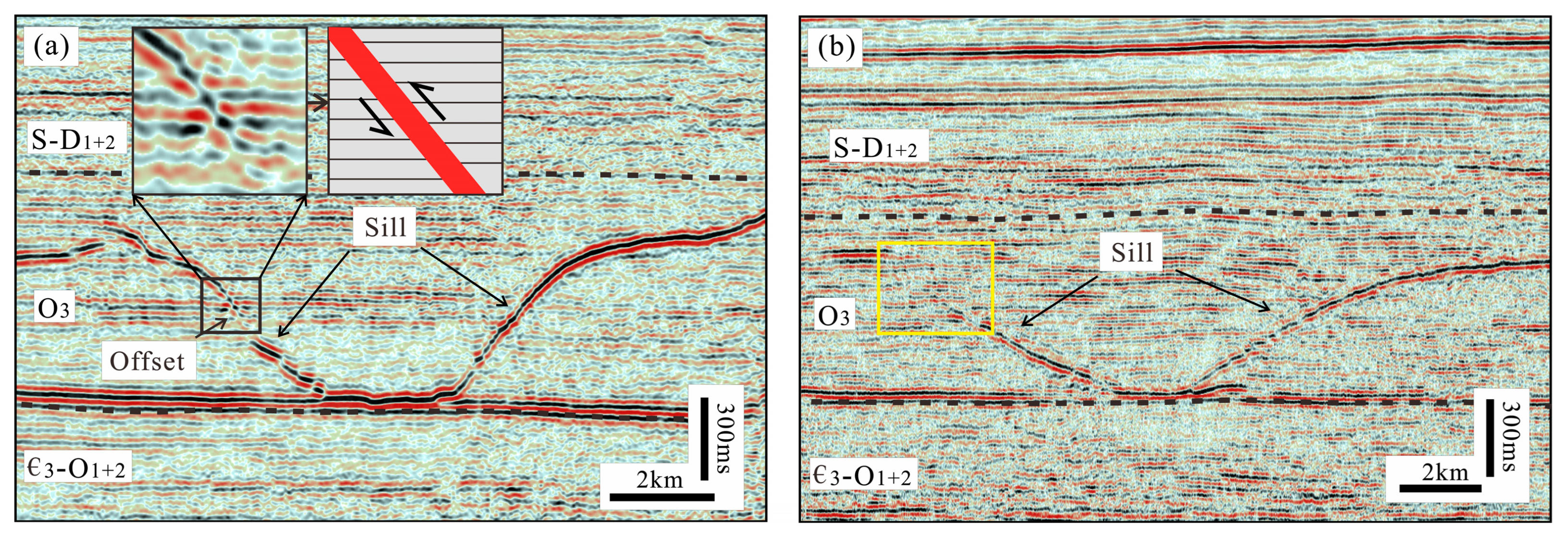
4.2. Distribution of Igneous Sill
4.3. Geometry of Igneous Sills
5. Discussion
5.1. Uplifting of the Overburden and Dating the Sill Emplacement
5.2. Controls on the Sill Geometry
5.3. Lithology of the Sills
5.4. Timing of Sill Emplacement
5.5. Geological Implications
6. Conclusions
Funding
Data Availability Statement
Acknowledgments
Conflicts of Interest
References
- Galland, O.; Bertelsen, H.; Eide, C.; Guldstrand, F.; Haug, Ø.T.; Leanza, H.A.; Mair, K.; Palma, O.; Planke, S.; Rabbel, O.; et al. Storage and Transport of Magma in the Layered Crust—Formation of Sills and Related Flat-Lying Intrusions. In Volcanic and Igneous Plumbing Systems; Steffi, B., Steffi, B., Eds.; Elsevier: Amsterdam, The Netherlands, 2018; pp. 113–138. [Google Scholar]
- Sigmundsson, F.; Parks, M.; Pedersen, R.; Jónsdóttir, K.; Ófeigsson, B.G.; Grapenthin, R.; Dumont, S.; Einarsson, P.; Drouin, V.; Heimisson, E.R.; et al. Chapter 11—Magma Movements in Volcanic Plumbing Systems and their Associated Ground Deformation and Seismic Patterns. In Volcanic and Igneous Plumbing Systems; Burchardt, S., Burchardt, S., Eds.; Elsevier: Amsterdam, The Netherlands, 2018; pp. 285–322. [Google Scholar]
- Cartwright, J.; Hansen, D.M. Magma transport through the crust via interconnected sill complexes. Geology 2006, 34, 929–932. [Google Scholar] [CrossRef]
- Hansen, D.M.; Cartwright, J.A.; Thomas, D. 3D seismic analysis of the geometry of igneous sills and sill junction relationships. In 3D Seismic Technology: Application to the Exploration of Sedimentary Basins; Davies, R.J., Cartwright, J.A., Stewart, S.A., Lappin, M., Underhill, J.R., Eds.; Geological Society: London, UK, 2004; pp. 199–208. [Google Scholar]
- Polteau, S.; Mazzini, A.; Galland, O.; Planke, S.; Malthe-Sørenssen, A. Saucer-shaped intrusions: Occurrences, emplacement and implications. Earth Planet. Sci. Lett. 2008, 266, 195–204. [Google Scholar] [CrossRef]
- Planke, S.; Rasmussen, T.; Rey, S.S.; Myklebust, R. Seismic characteristics and distribution of volcanic intrusions and hydrothermal vent complexes in the Vøring and Møre basins. In Petroleum Geology: North-West Europe and Global Perspectives—Proceedings of the 6th Petroleum Geology Conference; Geological Society of London: London, UK, 2005. [Google Scholar]
- Cukur, D.; Horozal, S.; Kim, D.C.; Lee, G.H.; Han, H.C.; Kang, M.H. The distribution and characteristics of the igneous complexes in the northern East China Sea Shelf Basin and their implications for hydrocarbon potential. Mar. Geophys. Res. 2010, 31, 299–313. [Google Scholar] [CrossRef]
- Jackson, C.A.L.; Schofield, N.; Golenkov, B. Geometry and controls on the development of igneous sill-related forced folds: A 2-D seismic reflection case study from offshore southern Australia. Geol. Soc. Am. Bull. 2013, 125, 1874–1890. [Google Scholar] [CrossRef]
- Magee, C.; Jackson, C.A.L.; Schofield, N. Diachronous sub-volcanic intrusion along deep-water margins: Insights from the Irish Rockall Basin. Basin Res. 2014, 26, 85–105. [Google Scholar] [CrossRef]
- Pang, Y.; Zhang, X.; Xiao, G.; Shang, L.; Guo, X.; Wen, Z. The Mesozoic-Cenozoic igneous intrusions and related sediment-dominated hydrothermal activities in the South Yellow Sea Basin, the Western Pacific continental margin. J. Mar. Syst. 2018, 180, 152–161. [Google Scholar]
- Magee, C.; Muirhead, J.D.; Karvelas, A.; Holford, S.P.; Jackson, C.A.; Bastow, I.D.; Schofield, N.; Stevenson, C.; McLean, C.; McCarthy, W.; et al. Lateral magma flow in mafic sill complexes. Geosphere 2016, 12, 809–841. [Google Scholar] [CrossRef]
- Spacapan, J.B.; Galland, O.; Leanza, H.A.; Planke, S. Igneous sill and finger emplacement mechanism in shale-dominated formations: A field study at Cuesta del Chihuido, Neuquén Basin, Argentina. J. Geol. Soc. 2017, 174, 422–433. [Google Scholar] [CrossRef]
- Yao, Z.; He, G.; Li, C.; Dong, C. Sill geometry and emplacement controlled by a major disconformity in the Tarim Basin, China. Earth Planet. Sci. Lett. 2018, 501, 37–45. [Google Scholar]
- Bischoff, A.; Nicol, A.; Barrier, A.; Wang, H. Paleogeography and volcanic morphology reconstruction of a buried monogenetic volcanic field (part 2). Bull. Volcanol. 2019, 81, 57. [Google Scholar] [CrossRef]
- Aarnes, I.; Svensen, H.; Connolly, J.A.D.; Podladchikov, Y.Y. How contact metamorphism can trigger global climate changes: Modeling gas generation around igneous sills in sedimentary basins. Geochim. Cosmochim. Acta 2010, 74, 7179–7195. [Google Scholar] [CrossRef]
- Spacapan, J.B.; Palma, J.O.; Galland, O.; Manceda, R.; Rocha, E.; D’Odorico, A.; Leanza, H.A. Thermal impact of igneous sill-complexes on organic-rich formations and implications for petroleum systems: A case study in the northern Neuquén Basin, Argentina. Mar. Pet. Geol. 2018, 91, 519–531. [Google Scholar] [CrossRef]
- Svensen, H.; Planke, S.; Malthe-Sørenssen, A.; Jamtveit, B.; Myklebust, R.; Eidem, T.R.; Rey, S.S. Release of methane from a volcanic basin as a mechanism for initial Eocene global warming. Nature 2004, 429, 542–545. [Google Scholar] [CrossRef]
- Aarnes, I.; Svensen, H.; Polteau, S.; Planke, S. Contact metamorphic devolatilization of shales in the Karoo Basin, South Africa, and the effects of multiple sill intrusions. Chem. Geol. 2011, 281, 181–194. [Google Scholar] [CrossRef]
- Svensen, H.; Corfu, F.; Polteau, S.; Hammer, Ø.; Planke, S. Rapid magma emplacement in the Karoo Large Igneous Province. Earth Planet. Sci. Lett. 2012, 325–326, 1–9. [Google Scholar] [CrossRef]
- Coetzee, A.; Kisters, A.F.M.; Chevallier, L. Sill complexes in the Karoo LIP: Emplacement controls and regional implications. J. Afr. Earth Sci. 2019, 158, 103517. [Google Scholar] [CrossRef]
- Wang, T.; Liu, J. Preliminary study on the basin-forming period and rifting of Tarim. In Research on Oil and Gas Geology of the Northern Tarim Basin, China; Jia, R., Ed.; China University of Geosciences Press: Beijing, China, 1991; pp. 115–124. [Google Scholar]
- Yu, X.; Yang, S.; Chen, H.; Chen, Z.; Li, Z.; Batt, G.E.; Li, Y. Permian flood basalts from the Tarim Basin, Northwest China: SHRIMP zircon U–Pb dating and geochemical characteristics. Gondwana Res. 2011, 20, 485–497. [Google Scholar] [CrossRef]
- Li, Z.; Chen, H.; Song, B.; Li, Y.; Yang, S.; Yu, X. Temporal evolution of the Permian large igneous province in Tarim Basin in northwestern China. J. Asian Earth Sci. 2011, 42, 917–927. [Google Scholar] [CrossRef]
- Pu, R.; Dang, X.; Xu, J.; Guo, Q.; Yi, H. Permian division and correlation and distribution of volcanic rocks of Tarim basin. Acta Petrol. Sin. 2011, 27, 166–180. [Google Scholar]
- Xu, Y.; Wei, X.; Luo, Z.; Liu, H.; Cao, J. The Early Permian Tarim Large Igneous Province: Main characteristics and a plume incubation model. Lithos 2014, 204, 20–35. [Google Scholar] [CrossRef]
- Yang, S.; Chen, H.; Li, Z.; Li, Y.; Yu, X.; Li, D. Early Permian Tarim Large Igneous Province in northwest China. Sci. China Earth Sci. 2014, 44, 187–199. (In Chinese) [Google Scholar] [CrossRef]
- Shangguan, S.; Peate, I.U.; Tian, W.; Xu, Y. Re-evaluating the geochronology of the Permian Tarim magmatic province: Implications for temporal evolution of magmatism. J. Geol. Soc. 2016, 173, 228–239. [Google Scholar] [CrossRef]
- Blacker, K.J.; Wang, Z.; Zhang, Z.; Reichow, M.K. New Estimates on the Basalt Volume of the Tarim (Not So Large) Igneous Province, NW China. J. Geophys. Res. Solid Earth 2021, 126, e2021JB022061. [Google Scholar] [CrossRef]
- Magee, C.; Maharaj, S.M.; Wrona, T.; Jackson, C.A.L. Controls on the expression of igneous intrusions in seismic reflection data. Geosphere 2015, 11, 1024–1041. [Google Scholar] [CrossRef]
- Cheng, H.; Li, J.; Zhao, X.; Pan, Y. Seismic interpretation of occurrence Permian Magnatite and its emplacement in Tabei uplift, Tarim Basin. Acta Petrol. Sin. 2010, 26, 283–290. [Google Scholar]
- Ji, T.; Yang, W.; Pu, R.; Wu, X.; Wu, X. Analysis of vertical position relationships between igneous sills and an unconformity surface—Interpretation of seismic profiles from the Northern Tarim Basin, NW China. Interpretation 2020, 8, T739–T752. [Google Scholar] [CrossRef]
- Tian, W.; Li, X.; Wang, L. Forced Fold Amplitude and Sill Thickness Constrained by Wireline and 3-D Seismic Data Suggest an Elastic Magma-Induced Deformation in Tarim Basin, NW China. Minerals 2021, 11, 293. [Google Scholar] [CrossRef]
- Lin, C.; Yang, H.; Liu, J.; Rui, Z.; Cai, Z.; Zhu, Y. Distribution and erosion of the Paleozoic tectonic unconformities in the Tarim Basin, Northwest China: Significance for the evolution of paleo-uplifts and tectonic geography during deformation. J. Asian Earth Sci. 2012, 46, 1–19. [Google Scholar] [CrossRef]
- Yang, H.; Deng, X.; Zhang, Y.; Xie, Z.; Li, Y.; Li, S.; Zhang, H.; Zhu, Y.; Chen, Y. A great discovery and its significance for exploration of Ordovician ultra-deep fault-controlled carbonate reservoirs in Well Manshen 1 in the Tarim Basin. China Pet. Explor. 2020, 25, 13–23. [Google Scholar]
- Kang, Y.Z.; Kang, Z.H. Tectonic evolution and oil and gas of Tarim basin. J. Southeast Asian Earth Sci. 1996, 13, 317–325. [Google Scholar]
- Sun, Q.; Fan, T.; Gao, Z.; Wu, J.; Zhang, H.; Jiang, Q.; Liu, N.; Yuan, Y. New insights on the geometry and kinematics of the Shunbei 5 strike-slip fault in the central Tarim Basin, China. J. Struct. Geol. 2021, 150, 104400. [Google Scholar] [CrossRef]
- Chang, H.; Hou, G.; Huang, S.; Luo, C.; Xia, J.; Zhong, Z.; Li, X.; Wei, L. Analysis of proto-type Tarim Basin in the late Precambrian and the dynamic mechanism of its evolution. PLoS ONE 2023, 18, e0286849. [Google Scholar] [CrossRef]
- Sobel, E.R.; Dumitru, T.A. Thrusting and exhumation around the margins of the western Tarim basin during the India-Asia collision. J. Geophys. Res. Solid Earth 1997, 102, 5043–5063. [Google Scholar] [CrossRef]
- Huafu, L.; Howell, D.G.; Dong, J.; Dongsheng, C.; Shimin, W.; Chuming, C.; Valin, Z.C.; Yangshen, S. Rejuvenation of the Kuqa Foreland Basin, Northern Flank of the Tarim Basin, Northwest China. Int. Geol. Rev. 1994, 36, 1151–1158. [Google Scholar] [CrossRef]
- Chen, N.; Dong, J.; Yang, S.; Chen, J.; Li, Z.; Ni, N. Restoration of geometry and emplacement mode of the Permian mafic dyke swarms in Keping and its adjacent areas of the Tarim Block, NW China. Lithos 2014, 204, 73–82. [Google Scholar] [CrossRef]
- Zhong, Y.; Lou, Z.; Mundil, R.; Wei, X.; Liu, H.; He, B.; Huang, X.; Tian, W.; Xu, Y. Constraining the duration of the Tarim flood basalts (northwestern China): CA-TIMS zircon U-Pb dating of tuffs. GSA Bull. 2022, 123, 325–334. [Google Scholar] [CrossRef]
- Hansen, D.M.; Cartwright, J. The three-dimensional geometry and growth of forced folds above saucer-shaped igneous sills. J. Struct. Geol. 2006, 28, 1520–1535. [Google Scholar] [CrossRef]
- Sun, Q.; Wu, S.; Cartwright, J.; Wang, S.; Lu, Y.; Chen, D.; Dong, D. Neogene igneous intrusions in the northern South China Sea: Evidence from high-resolution three dimensional seismic data. Mar. Pet. Geol. 2014, 54, 83–95. [Google Scholar] [CrossRef]
- Yao, Z.; Li, C.; He, G.; Tao, T.; Zheng, X.; Zhang, T.; Tang, X.; Zhao, T. Cenozoic sill intrusion in the central and southern East China Sea Shelf Basin. Mar. Pet. Geol. 2020, 119, 104465. [Google Scholar] [CrossRef]
- Luo, F. Study on Characteristics and Predicting Technology of Igneous Rocks in Tazhong Area of Tarim Basin. Ph.D. Thesis, China University of Geosciences (Beijing), Beijing, China, 2006. [Google Scholar]
- Magee, C.; Briggs, F.; Jackson, C.A.L. Lithological controls on igneous intrusion-induced ground deformation. J. Geol. Soc. 2013, 170, 853–856. [Google Scholar] [CrossRef]
- Galland, O.; Planke, S.; Neumann, E.; Malthe-Sørenssen, A. Experimental modelling of shallow magma emplacement: Application to saucer-shaped intrusions. Earth Planet. Sci. Lett. 2009, 277, 373–383. [Google Scholar] [CrossRef]
- Ma, Z.; Ren, L.; Huang, W.; Yue, X. Basic characteristics of igneous rock in the middle area of Tarim Basin. Spec. Oil Gas Reserv. 2013, 20, 64–67. [Google Scholar]
- Pollard, D.D.; Johnson, A.M. Mechanics of growth of some laccolithic intrusions in the Henry mountains, Utah, II: Bending and failure of overburden layers and sill formation. Tectonophysics 1973, 18, 311–354. [Google Scholar] [CrossRef]
- Kavanagh, J.L.; Menand, T.; Sparks, R.S.J. An experimental investigation of sill formation and propagation in layered elastic media. Earth Planet. Sci. Lett. 2006, 245, 799–813. [Google Scholar] [CrossRef]
- Menand, T. The mechanics and dynamics of sills in layered elastic rocks and their implications for the growth of laccoliths and other igneous complexes. Earth Planet. Sci. Lett. 2008, 267, 93–99. [Google Scholar] [CrossRef]
- Chen, T.; Cheng, S.; Fang, Q.; Zhou, C. Numerical modeling of shallow magma intrusions with finite element method. J. Volcanol. Geotherm. Res. 2017, 333–334, 53–65. [Google Scholar] [CrossRef]
- Wei, X.; Xu, Y. Petrogenesis of the mafic dykes from Bachu and implications for the magma evolution of the Tarim large igneous province, NW China. Acta Petrol. Sin. 2013, 29, 3323–3335. [Google Scholar]
- Chen, H.; Yang, S.; Li, Z.; Yu, X.; Lou, J.; He, G.; Lin, X.; Wang, Q. Spatial and temporal characteristics of Permian large igneous province in Tarim basin. Xinjiang Pet. Geol. 2009, 30, 179–182. [Google Scholar]
- Magee, C.; Jackson, C.A.L.; Hardman, J.P.; Reeve, M.T. Decoding sill emplacement and forced fold growth in the Exmouth Sub-basin, offshore northwest Australia: Implications for hydrocarbon exploration. Interpretation 2017, 5, SK11–SK22. [Google Scholar] [CrossRef]
- Rohrman, M. Intrusive large igneous provinces below sedimentary basins: An example from the Exmouth Plateau (NW Australia). J. Geophys. Res. Solid Earth 2013, 118, 4477–4487. [Google Scholar] [CrossRef]
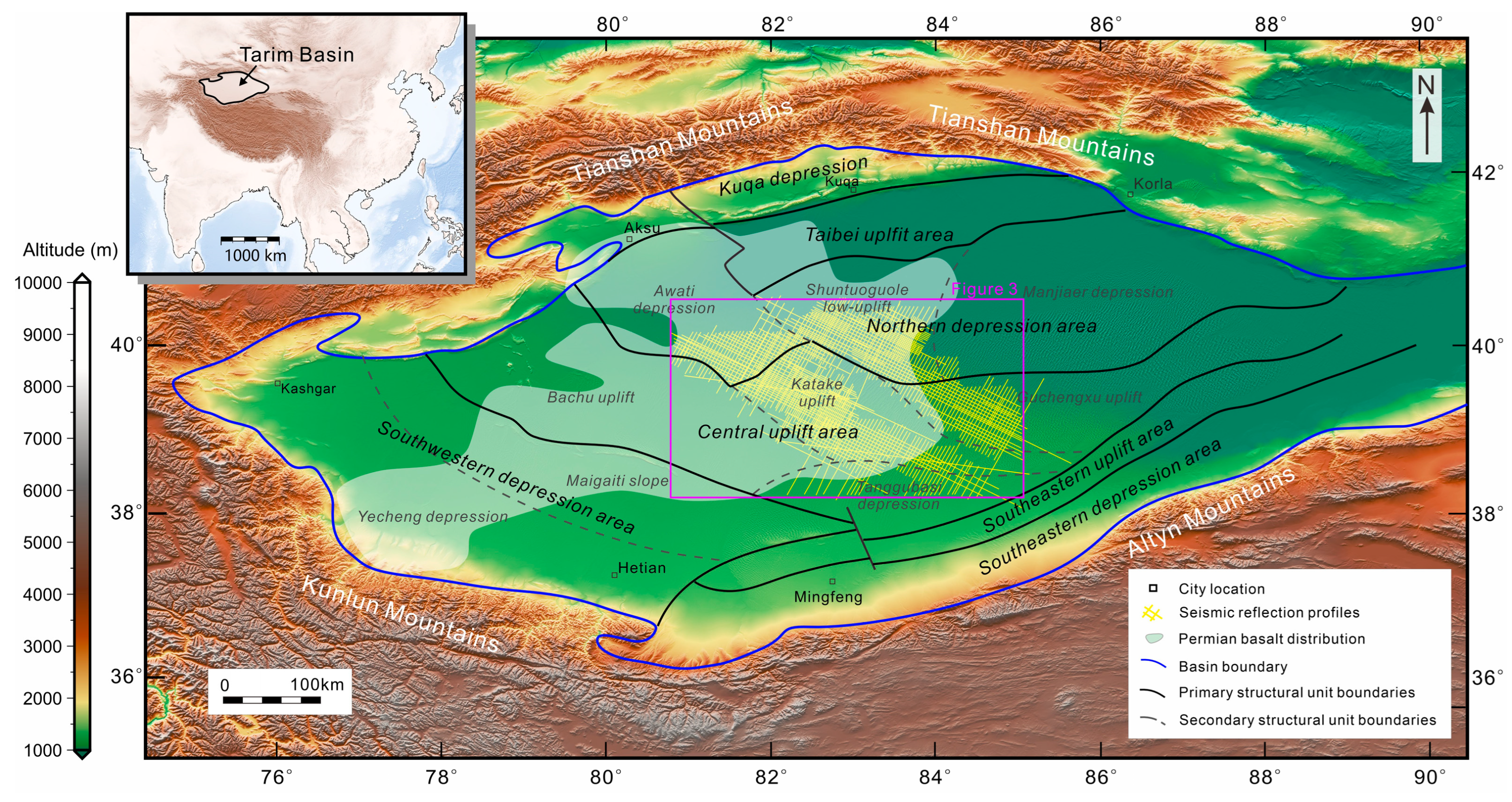
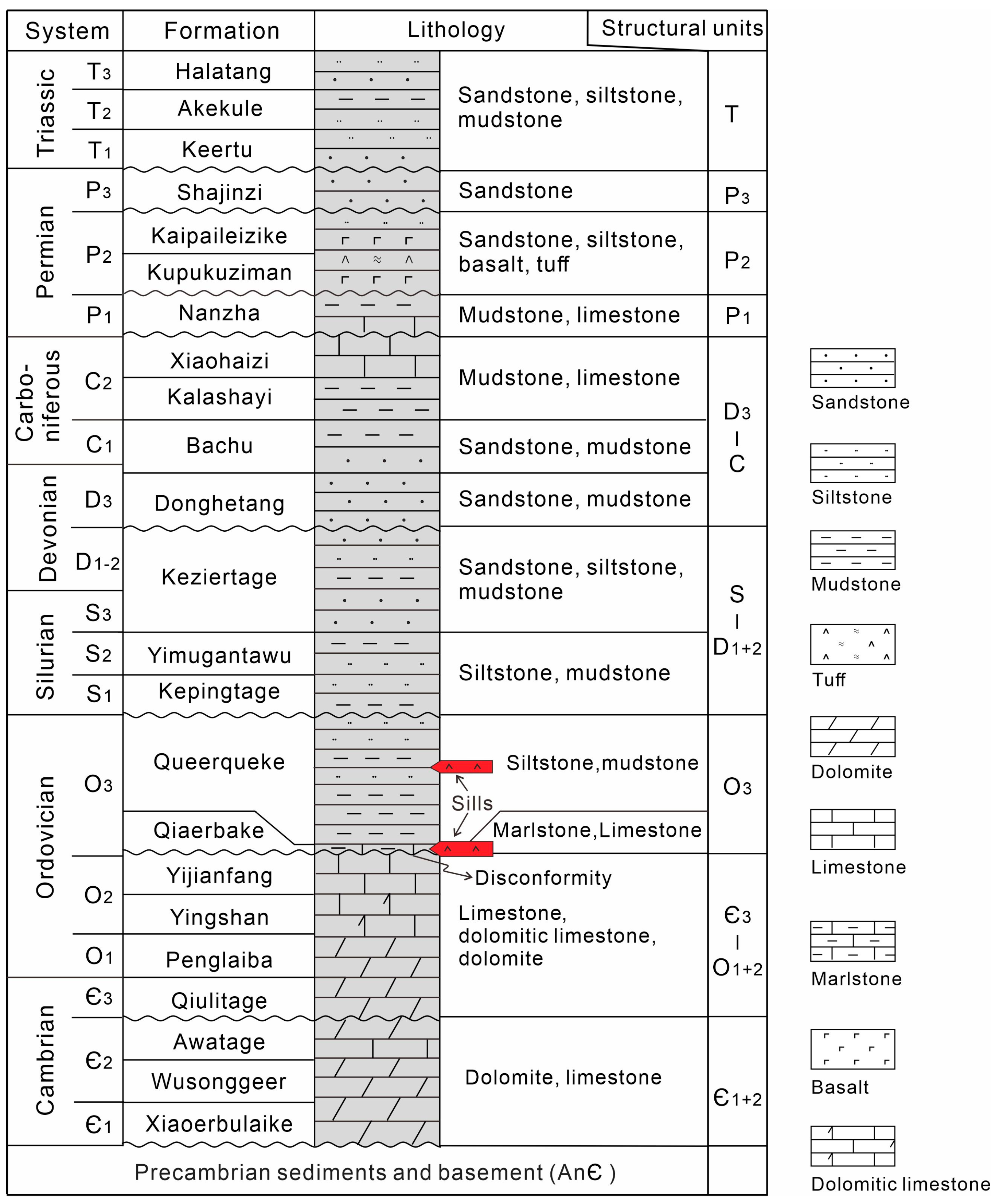


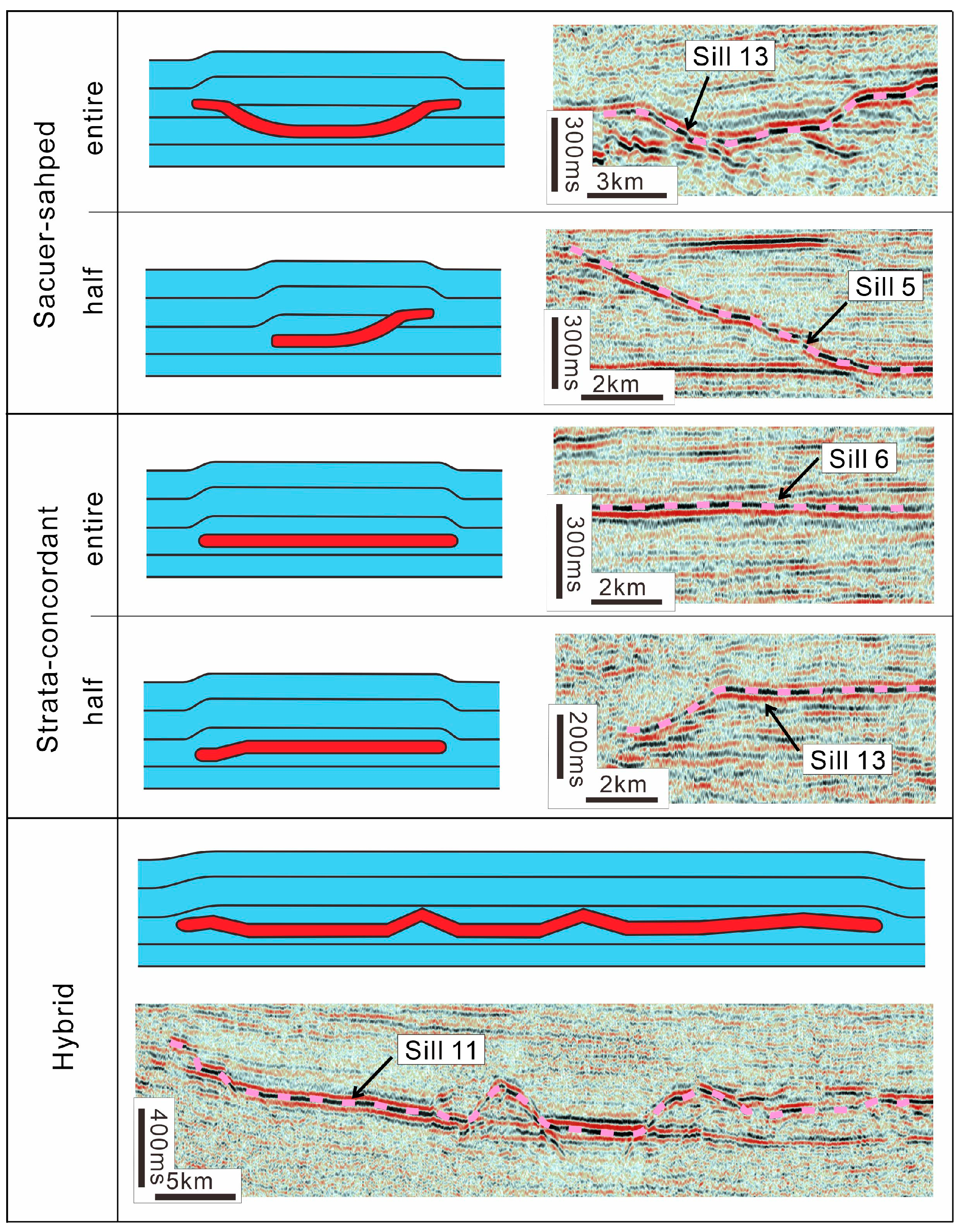

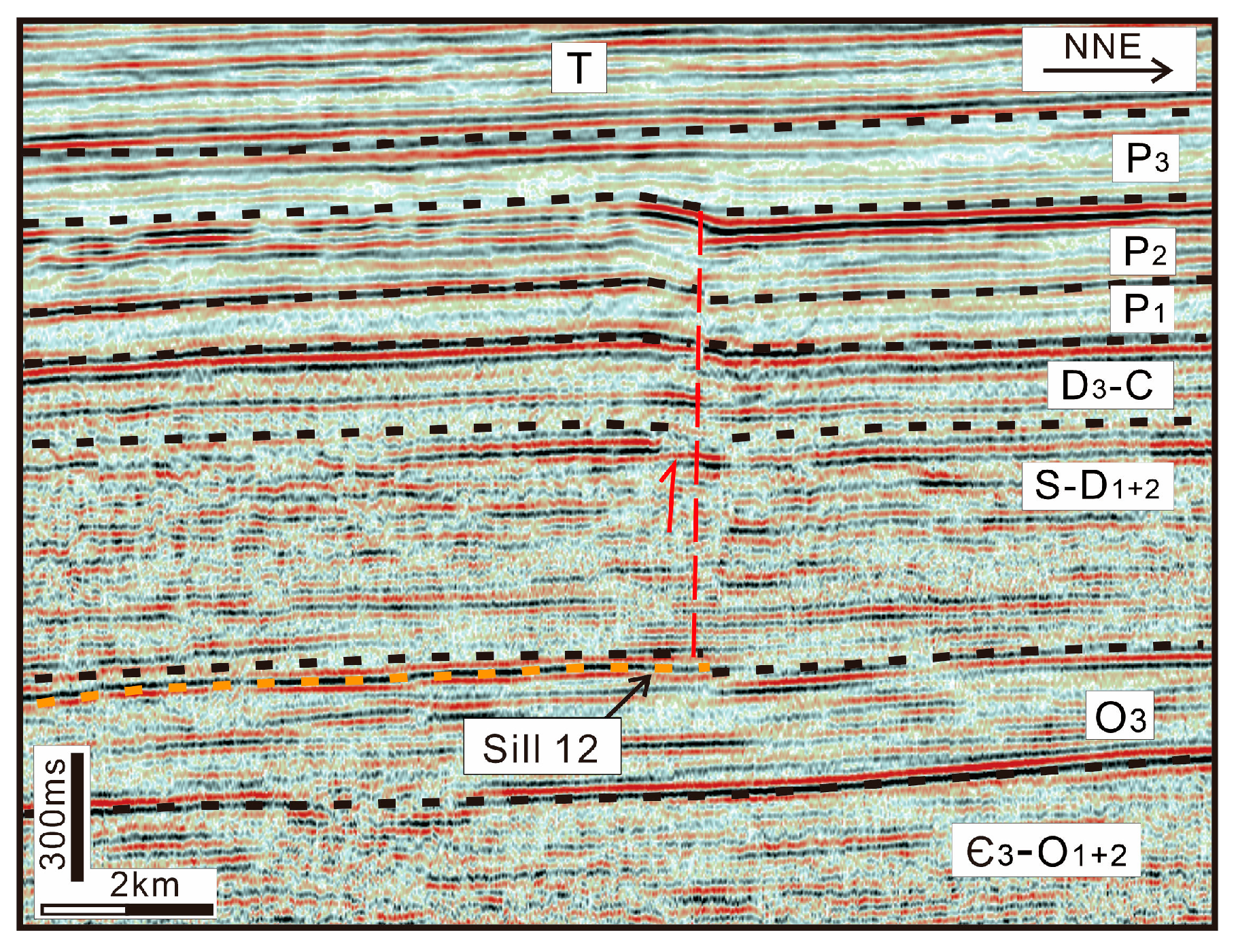
| No. | Plane Area (km2) | Geometric Types | Overlapping Locations | Overlapping Area (km2) |
|---|---|---|---|---|
| 1 | 1879.56 | Hybrid sills | ||
| 2 | 16.89 | Half saucer-shaped | ||
| 3 | 171.56 | Half saucer-shaped | ||
| 4 | 739.11 | Hybrid | 4, 5 | |
| 5 | 580.44 | Half saucer-shaped | 5, 6 | 243.55 |
| 6 | 264.00 | Strata-concordant | ||
| 7 | 121.33 | Saucer-shaped | 7, 8 | 111.11 |
| 8 | 433.33 | Half Strata-concordant | ||
| 9 | 472.00 | Saucer-shaped | ||
| 10 | 507.11 | Half saucer-shaped | ||
| 11 | 2150.67 | Hybrid | 11, 12 | 471.55 |
| 12 | 471.56 | Strata-concordant | 11, 13 | 118.22 |
| 13 | 802.67 | Saucer-shaped | 13, 14 | 149.78 |
| 14 | 1246.22 | Hybrid | 14, 15 | 324.89 |
| 15 | 324.89 | Saucer-shaped | ||
| 16 | 63.56 | Saucer-shaped | 14, 16 | 63.56 |
| 17 | 46.22 | Saucer-shaped | 11, 17 | 30.22 |
| 18 | 140.44 | Half saucer-shaped | ||
| Total | 10,628.00 | 1512.89 | ||
| Area with overlapping | 9115.11 |
Disclaimer/Publisher’s Note: The statements, opinions and data contained in all publications are solely those of the individual author(s) and contributor(s) and not of MDPI and/or the editor(s). MDPI and/or the editor(s) disclaim responsibility for any injury to people or property resulting from any ideas, methods, instructions or products referred to in the content. |
© 2024 by the author. Licensee MDPI, Basel, Switzerland. This article is an open access article distributed under the terms and conditions of the Creative Commons Attribution (CC BY) license (https://creativecommons.org/licenses/by/4.0/).
Share and Cite
Yao, Z. Spatial and Temporal Distribution of Igneous Sills in the Central Tarim Basin and Their Geological Implications. Minerals 2024, 14, 862. https://doi.org/10.3390/min14090862
Yao Z. Spatial and Temporal Distribution of Igneous Sills in the Central Tarim Basin and Their Geological Implications. Minerals. 2024; 14(9):862. https://doi.org/10.3390/min14090862
Chicago/Turabian StyleYao, Zewei. 2024. "Spatial and Temporal Distribution of Igneous Sills in the Central Tarim Basin and Their Geological Implications" Minerals 14, no. 9: 862. https://doi.org/10.3390/min14090862
APA StyleYao, Z. (2024). Spatial and Temporal Distribution of Igneous Sills in the Central Tarim Basin and Their Geological Implications. Minerals, 14(9), 862. https://doi.org/10.3390/min14090862







